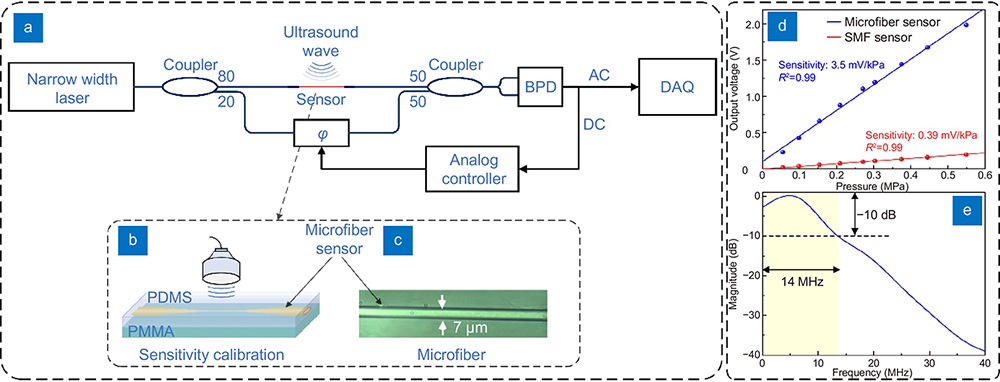- Opto-Electronic Advances
- Vol. 6, Issue 6, 230065 (2023)
Abstract
In this work, a microfiber was applied to ultrasound sensing for the first time. Based on dual sensitization of microfiber evanescent field and PDMS package with high elastic coefficient, ultrahigh sensitivity ultrasound detection has been realized. Microfiber, as the sensing element, has the characteristics of small diameter and good flexibility, which provides the feasibility for the miniaturization of ultrasound sensor. Specifically, this linear lateral sensitive ultrasound sensor is very suitable for endoscopic photoacoustic imaging of abdominal blood vessels as shown in
![]()
Figure 1.(
As the key element of a photoacoustic imaging system, ultrasound sensors directly determine the imaging performance. The mainstream ultrasound sensors are based on the piezoelectric effect, which converts mechanical waves into electric charges
![]()
Figure 2.(
Photoacoustic imaging generates ultrasound waves by irradiating biological tissues with pulses or modulated continuous lasers. Ultrasound sensors are used to capture ultrasound signals in a distributed manner. Then, the light absorption distribution of biological tissues can be reconstructed with the help of image reconstruction algorithms. Compared with optical imaging, photoacoustic imaging provides higher spatial resolution, greater penetration depth and selective optical absorption contrast, thereby enabling detailed visualization of the distribution of hemoglobin, lipid, melanin, and other chromophores in biological tissues
Fiber optic sensors
In the recent work published in Opto-Electronic Advances (OEA), Prof. Sun et al. have proposed a highly sensitive and miniature microfiber-based ultrasound sensor for photoacoustic tomography
The research also demonstrated a photoacoustic imaging system based on the microfiber ultrasound sensor. The system achieved a signal-to-noise ratio (SNR) of 31 dB at the imaging depth of 12 mm, with a the lateral resolution of 250 μm and an axial resolution of 65 μm. This system exhibited the advantages of high resolution, large imaging depth and side photoacoustic/ultrasound imaging, demonstrating the great potential of applying the microfiber ultrasound sensor in medical and industrial applications.
References
[1] CH Li, LV Wang. Photoacoustic tomography and sensing in biomedicine. Phys Med Biol, 54, R59-R97(2009).
[2] YQ Qiu, JV Gigliotti, M Wallace, F Griggio, CEM Demore et al. Piezoelectric Micromachined Ultrasound Transducer (PMUT) arrays for integrated sensing, actuation and imaging. Sensors, 15, 8020-8041(2015).
[3] HB Fan, L Zhang, S Gao, L Chen, XY Bao. Ultrasound sensing based on an in-fiber dual-cavity Fabry-Perot interferometer. Opt Lett, 44, 3606-3609(2019).
[4] XD Ma, YQ Cai, B Fu, LJ Xu, JG Ma. Fiber optic-based laser interferometry array for three-dimensional ultrasound sensing. Opt Lett, 44, 5852-5855(2019).
[5] JA Guggenheim, J Li, TJ Allen, RJ Colchester, S Noimark et al. Ultrasensitive plano-concave optical microresonators for ultrasound sensing. Nat Photonics, 11, 714-719(2017).
[6] X Bai, YM Qi, YZ Liang, J Ma, L Jin et al. Photoacoustic computed tomography with lens-free focused fiber-laser ultrasound sensor. Biomed Opt Express, 10, 2504-2512(2019).
[7] LY Yang, YP Li, F Fang, LY Li, ZJ Yan et al. Highly sensitive and miniature microfiber-based ultrasound sensor for photoacoustic tomography. Opto-Electron Adv, 5, 200076(2022).
[8] M Yao, YX Zhang, X Ouyang, AP Zhang, HY Tam et al. Ultracompact optical fiber acoustic sensors based on a fiber-top spirally-suspended optomechanical microresonator. Opt Lett, 45, 3516-3519(2020).

Set citation alerts for the article
Please enter your email address



